Apple's 2010 MacBook Air (11 & 13 inch) Thoroughly Reviewed
by Anand Lal Shimpi on October 26, 2010 10:08 PM EST- Posted in
- Mac
- Apple
- MacBook Air
- Laptops
The SSD: Not Half Bad
Apple advertises the new MacBook Air as being instant on as a result of the internal SSD. That’s mostly untrue. From a completely powered off state the MacBook Air still takes time to boot. That time is significantly reduced compared to the old MacBook Air and any other Mac with a conventional hard drive. It’s even a shorter boot than my MacBook Pro with a SandForce SF-1200 based SSD in it:
| System Performance Comparison | ||||||
| Boot | Shut Down | Sleep | Awake | |||
| 11-inch MacBook Air | 15.5 seconds | 2.2 seconds | 1.0 second | 1.63 seconds | ||
| 13-inch MacBook Air | 14.4 seconds | 1.9 seconds | 1.0 second | 1.56 seconds | ||
| 13-inch MacBook Air (Late 2008) | 34.4 seconds | 2.9 seconds | 1.6 seconds | 4.19 seconds | ||
| 15-inch MacBook Pro (SF-1200 SSD) | 19.1 seconds | 1.8 seconds | 1.5 seconds | 2.3 seconds | ||
| 15-inch MacBook Pro (Mid 2009, HDD) | 34.2 seconds | 2.8 seconds | 1.8 seconds | 2.1 seconds | ||
You'll notice that even the SF-1200 SSD in my 15-inch MacBook Pro takes longer to boot than these new Airs. Apple does customize the firmware on its SSDs. I’d be willing to bet the SSD in the MacBook Air has tight integration with OS X to guarantee quicker than normal boot times.
Clearly the new Air isn't instant on from a boot standpoint, but it's pretty much there from a recover-from-sleep standpoint. The new Airs both go to sleep and wake up from sleep quicker than any of the other Macs, including my upgraded 15-inch Core i7 MacBook Pro. Again, nothing can trump Apple's tight integration between hardware and software.
Apple likes to work with two different controller manufacturers for SSDs: Samsung and Toshiba. iFixit already confirmed Toshiba is in the new MacBook Air with its teardown:
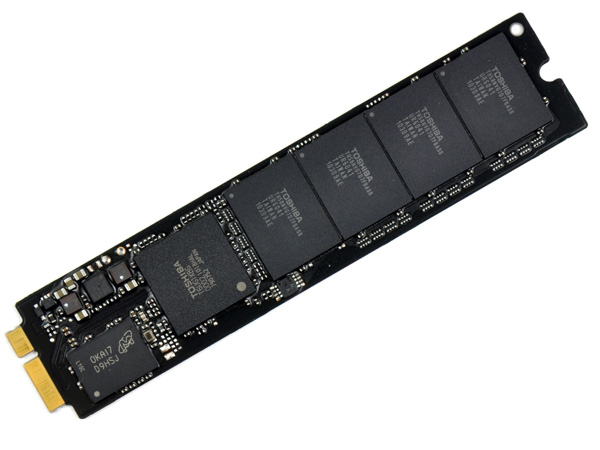
The 11-inch MacBook Air SSD, courtesy of iFixit
The SSD isn’t in an industry standard form factor, although the connector appears to be either micro or mini SATA. Presumably 3rd party SSD manufacturers (ahem, SandForce partners I’m looking at you) could produce drop in replacements for the MacBook Air SSD.
There’s nothing particularly innovative about the form factor of the SSD, other than Apple did away with the unnecessary space a 2.5” SSD would require. Just as SSDs will break the traditional SATA interface barriers, we’ll see the same happen to form factors as well.
The part number on the Toshiba controller may look familiar to some of you. It’s the same controller that’s in Kingston’s SSDNow V+ Series and the SSDNow V Series Boot Drive. I reviewed the latter not too long ago and found that it was a good drive for the money, and here’s the kicker: the SSDNow V Series Boot Drive was amazingly resilient when written to without TRIM support. Its performance hardly dropped as a result of normal desktop use. This is very important because although OS X 10.6.4 has a field for reporting TRIM support on an SSD, the instruction isn’t actually supported by the OS. Even the new MacBook Airs don’t ship with a version of OS X with TRIM support.
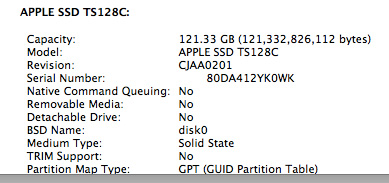
The SSD only has four NAND devices on it. Typically that would mean some very low transfer speeds, particularly on writes. But each one of those four devices has at least 16GB of NAND, spread across multiple planes and die. With the right firmware, you should be able to extract a good deal of parallelism from this architecture. Apple and Toshiba apparently do just that.

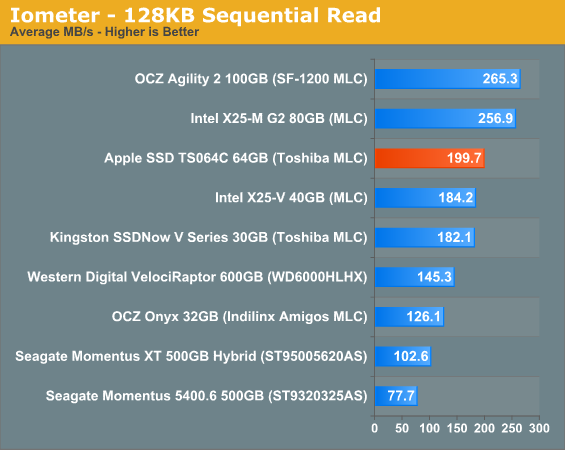
While most value SSDs top out at under 100MB/s, we get nearly 200MB/s sequential reads and writes out of the SSD in the new MacBook Air. And fortunately, Apple hasn’t only focused on sequential performance. The random read/write performance of the new MacBook Air SSD isn’t terrible:
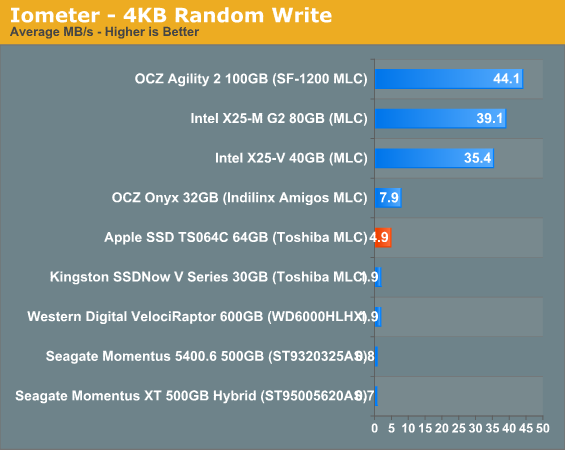
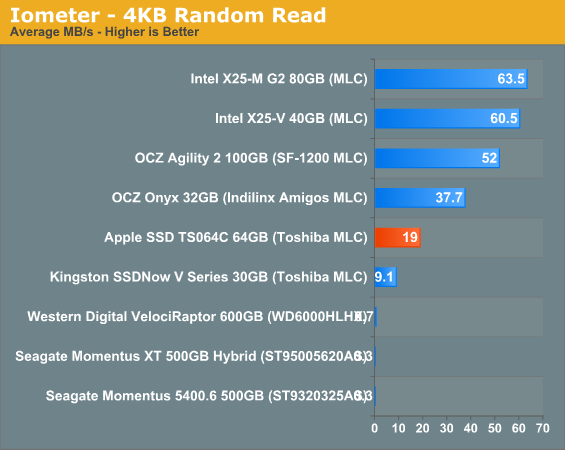
Random write performance is of course the weak point, but you’ll notice that it’s actually higher than the Kingston drive that uses the same controller. While Apple would’ve been better off striking a deal with Intel or SandForce for the controller in the MacBook Air, the Toshiba controller isn’t horrible.
As I mentioned earlier, resilience is very important as OS X still doesn’t support TRIM. I filled the drive with garbage and then tortured it for 20 minutes with random writes. The resulting performance drop was noticeable, but not unbearable:
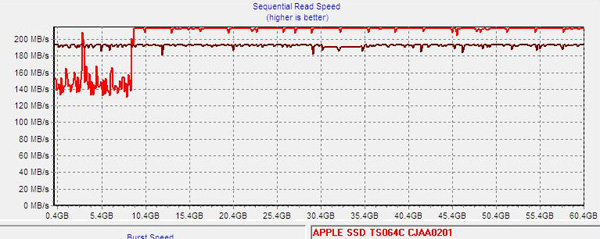
A single pass of sequential writes restores performance to normal:
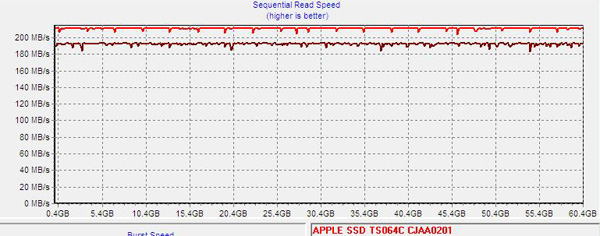
This tells us two things. First, through normal use the drive should be able to recover its performance over time (assuming you give it enough spare area). And second, if there’s any idle garbage collection in Apple’s custom firmware for the Toshiba controller it should be able to keep the drive running at peak performance even without TRIM supported in the OS. I don’t have a good way of measuring whether or not there’s GC enabled on the drive in OS X, but I suspect Apple is (at least it appears to be doing so on the Mac Pro’s SSDs).
Overall I’m pleased with Apple’s SSD selection. It could’ve been a lot better but it could’ve been a lot worse. The MacBook Airs in their default configuration have better IO performance than any other standard config Mac sold on the market today, including the Mac Pro.










185 Comments
View All Comments
dsee15 - Wednesday, October 27, 2010 - link
Great thanks. Until then as a technical site, does anyone have a sense what the faster proc and additional 2GB mem do to performance? For example, it should run 20% faster for cpu intense apps, etc.Shadowmaster625 - Wednesday, October 27, 2010 - link
Well if you're spending money on any of these crapple concraptions then you are either not being productive or simply getting paid too much. Like those retired public employees who get paid 6 figure pensions for doing nothing. I dont know when that crap will stop, but I imagine it will be at around the same time apple flirts with bankruptcy.michael2k - Wednesday, October 27, 2010 - link
They have more cash than Microsoft. So after Microsoft flirts with bankruptcy?Shadowmaster625 - Wednesday, October 27, 2010 - link
They do have a lot of cash. But I can easily see them burning up half of it buying back their own stock once it starts tanking. And the other half could be burned up by just one or two flops. And that can easily happen once most apple lovers realize we are in fact in a depression and there is just no place for a company like apple in a depression.ShepherdH - Wednesday, October 27, 2010 - link
they just gave you more RAM and a larger hard drive at them. Same with most other Apple products.iwodo - Wednesday, October 27, 2010 - link
When Apple gets SandyBridge, i suspect 32nm, SandyBridge 1.8Ghz could do so within the same 1.4Ghz C2D Power envelop. But will be much more powerful. The only trouble is Apple wants CPU to be CPU, not a CPU with GPU built in.khimera2000 - Wednesday, October 27, 2010 - link
im not sure about that. they might just be looking for a sweet spot with CPU and GPU performance. in which case AMD's APU chips should be an intresting prospect since it gives you modern architecture on both sides in one chip.where intel took two dies and just slaped them together,AMD made it so the CPU and GPU can actualy talk to each other, also if AMD is to be beleaved this core would be retasked in the presance of another AMD card so the video chip on the CPU dosent become dead weight like the intel solution which just shuts down entirely in the presence of another card. (at least thats what i read)
personaly i think apple should get back into building there own hardware just like the g4 days. but that would require building there own OS, and seeing as mac hasent built an OS from the ground up for a long time (last time being os9? check out something called OpenStep) it might not be in there best intrest with win 7 getting so much traction and the failings of there previous Operating Systems it might not be good for the company to build something there not good at creating.
khimera2000 - Wednesday, October 27, 2010 - link
actually i dont think thats the case. there looking for a balanced system, and to this day intel has not released anything that can run a modern title (that i know of) if intel had a half way descent architecture on there vid cards i could see apple using it.however as things stand intel does not have a descent processer, and thats the reason why they have to use an nvidia video card. being that these notebooks use intergrated memory i can see that apple is looking for a specific perfomance point for there systems.
with that in mind i dont see why they wouldent consider AMD's soon to releas offerings. these chips has better gpu/cpu intergration then intel's options and sports the latest DX11 video architecture AMD has. I dont think theres anything in intel's arsinal that would be able to but heads with these chips from a graphic stand point, the only rogue facter in this is the new CPU architecture, since it has to yet be released.
Speaking of which... when can we expect to see reviews of the amd APU offerings from Anand? i would love to see how well it ticks, and a review to better define what makes it so differant from the intel chips that are comming out... perhaps an architetual comparison sometime in the future???
khimera2000 - Wednesday, October 27, 2010 - link
wow... i didnt know my first post went through for this response.. sorry about that. my connection hickuped. Love the sight keep up the good work :Dblufire - Wednesday, October 27, 2010 - link
You stated that the software restore drive is not write-protected, but Apple states that it is read-only. Who's right?http://support.apple.com/kb/HT4399
Thanks for the review!